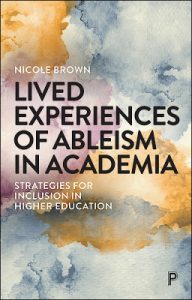
This is an extract from my contribution to the LSE Higher Education blog exploring key principles to ensure accessibility in higher education:
Drawing from the recommendations proposed in a recently published edited volume on ableism in academia, Nicole Brown shares her top-five list of accessibility hacks for teachers, lecturers, and speakers in higher education.
Here is my top-five list of little, inexpensive steps that will make higher education more accessible for staff and students:
Colour schemes
Presentation slides are commonly used in higher education settings to support teaching and dissemination of research. Yet, for many people the typical slides are difficult to navigate. Oliver Daddow highlights that one in 12 males and one in 200 females with Northern European ancestry have some form of colour blindness, and between five percent and 10 percent of the general population have dyslexia, add Jennifer Hiscock and Jennifer Leigh. One solution would be to use black writing on an off-white background.
Time
In this day and age, time is often money, and it does mean that we may not offer quite as much time as we should. For some individuals, however, as Robert Mann and Bryan Clift point out, time makes the difference between joining in and being excluded, as stammers and processing speeds worsen with the perceived added pressures and stresses of wanting to share thoughts and views. And slowing the pace is good for everyone anyway.
Microphones
Nowadays, most seminar rooms and lecture halls at universities are equipped with modern technology. Whiteboards, interactive or not, data projectors, and computers, are so commonplace that we cannot even remember a time where these gadgets were not part of the furnishings. Microphones are no different. Using the microphone is a first step that needs to be followed up with good microphone etiquette. If there are questions or comments from the floor that are brought forward without a microphone, maybe because there is not one in the room or because the person has forgotten about it, it is the speaker’s responsibility to repeat what was said first before commenting. For people who identify as hearing impaired, deaf or Deaf, these little changes to our practice make a huge difference.
Making allowances
It is difficult to accommodate everybody’s needs in a room, especially as many needs are conflicting. There are individuals who need near-absolute silence to be able to focus, while there are others who need to move around, stretch their legs, or tap their fingers. As Rosalind Janssen describes so emotively and impactfully, there sometimes just is not enough time to wait for the next opportunity to go to the toilet. Accommodating everyone is not easy. But restricting an accommodation to a particular group of people, for example to those with medical issues, is also problematic. In the spirit of universal design for learning, the compromise must be to allow individuals to move around, to consume foods and drinks, to use their gadgets, to do whatever they need to guarantee health and wellbeing. After all, we cannot concentrate on a lecture or conference presentation, when we are preoccupied with our bodily needs.
Mentoring and support
Arguably, the biggest theme running through the book, and connecting all conversations I have been privy to, is the need for mentoring and support. For the mentor to have some lived experience may be beneficial, but anyone can be an ally and advocate for the needs of others. We can speak up and educate others in accessibility, even if we, ourselves, don’t need those accommodations. That is true allyship.
Leave a message: